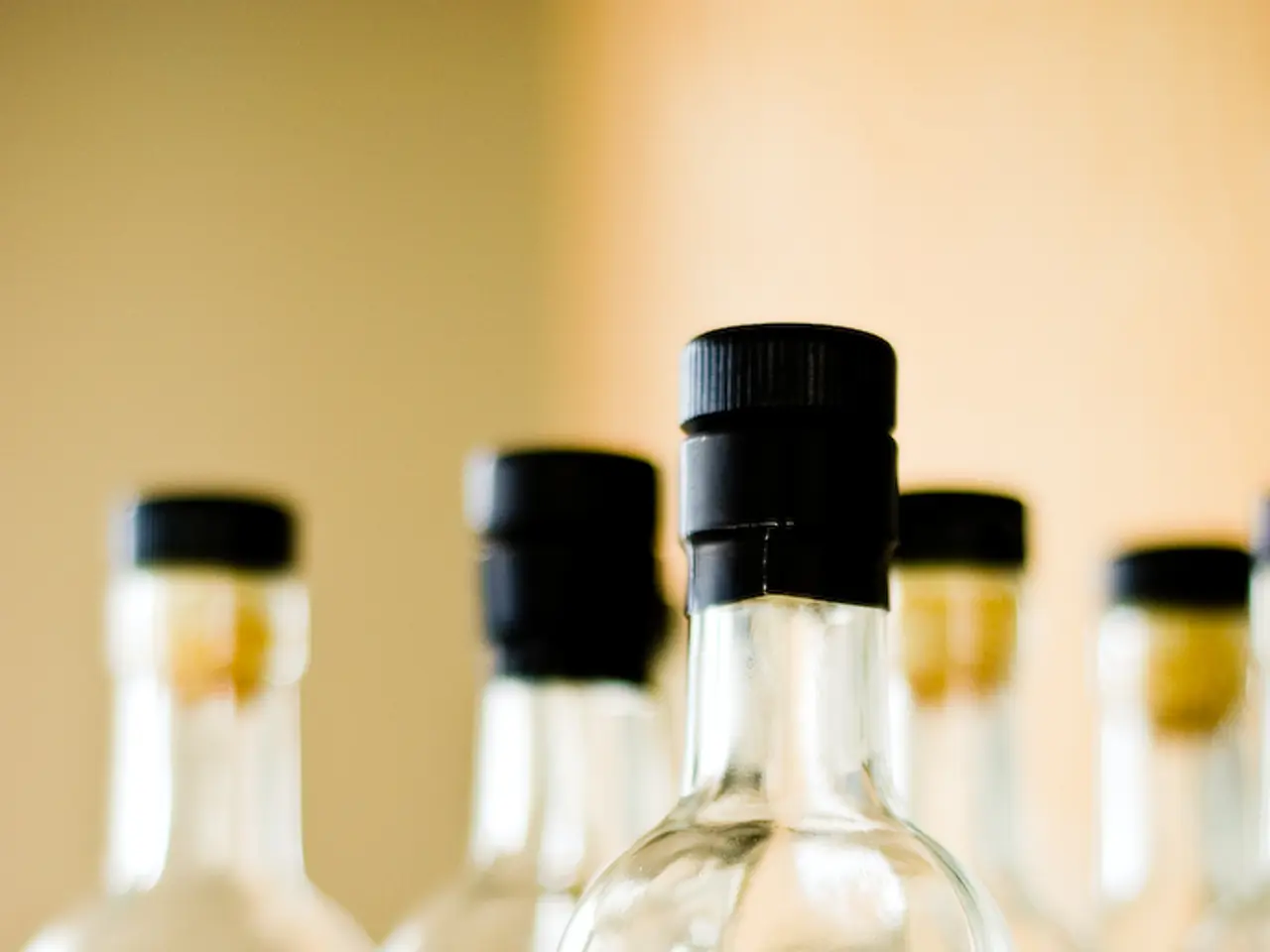Alcohol's impact on the skin, both short-term and long-term
In a world where the effects of alcohol on our bodies are often overlooked, it's essential to shed light on the impact it has on our skin health. Excessive alcohol consumption can lead to various skin conditions and premature aging.
In the short term, alcohol acts as a diuretic, dehydrating the body and causing dry, flaky skin. This dehydration can result in reduced oil production, leading to redness, irritation, and a flushed appearance due to blood vessel dilation. Alcohol also stimulates histamine release, worsening skin redness and puffiness. Sleep disruption from alcohol use can further exacerbate these temporary skin changes.
Over the long term, sustained heavy drinking is linked to chronic skin issues such as eczema and psoriasis flare-ups, premature skin aging, immune system impairment, nutritional deficiencies, and the development of alcohol-related skin conditions.
Eczema and psoriasis flare-ups are associated with alcoholism, particularly discoid eczema, characterized by itchy, scaly patches. Chronic dehydration and damage to the skin barrier lead to loss of elasticity and increased wrinkles, causing premature skin aging. The impaired immune response increases the risk of secondary infections, while nutritional deficiencies, especially of B vitamins, worsen skin health over time.
Alcohol-related skin conditions include acne, hives, rashes, spider veins, hyperpigmentation, dry patches, and signs of liver disease like redness, severe localized itching, and brown patches (hyperpigmentation).
Importantly, alcohol misuse can also impair liver function, which is correlated with skin manifestations like spider veins and jaundice, signaling serious health risks.
It's worth noting that alcohol may increase the risk of developing psoriasis and seborrheic dermatitis, and it's a risk factor for porphyria cutanea tarda (PCT).
In the fight against alcohol use disorder (AUD), treatments may involve medications, cognitive behavioral therapy, detox, inpatient or outpatient rehabilitation, peer support groups, and addressing underlying conditions.
To combat the short-term effects of alcohol on the skin, drinking water can help. Dehydration caused by alcohol can affect a person's skin, causing symptoms such as dry skin, sunken eyes, decreased skin elasticity, and dry, cracked lips.
Flushing is a potential side effect of drinking alcohol, affecting around 540 million people worldwide. Applying topical brimonidine (Mirvaso) before drinking alcohol may help reduce the appearance of flushing.
The Centers for Disease Control and Prevention (CDC) recommends that females should not consume more than 1 drink per day, and males should not consume more than 2 drinks per day. Anyone worried about their alcohol intake or who has difficulty managing it can contact a doctor or local support group for help.
In summary, excessive alcohol consumption disrupts skin hydration, immune defense, nutrition, and can provoke inflammatory and degenerative skin conditions in both the short and long term, highlighting the importance of moderation to maintain skin health.
- Alcohol's temporary impacts on skin include dryness, flakiness, redness, irritation, a flushed appearance, and skin puffiness, due to its diuretic effects and histamine release.
- Chronic alcohol consumption can lead to long-term skin issues such as eczema and psoriasis flare-ups, premature skin aging, immune system impairment, nutritional deficiencies, and the development of alcohol-related skin conditions.
- Eczema and psoriasis flare-ups, particularly discoid eczema, are associated with alcoholism, due to chronic dehydration and damage to the skin barrier.
- Over time, alcohol-related skin conditions may manifest as acne, hives, rashes, spider veins, hyperpigmentation, dry patches, and signs of liver disease like redness, severe localized itching, and brown patches (hyperpigmentation).
- Alcohol misuse can also impair liver function, leading to skin manifestations such as spider veins and jaundice, indicating serious health risks.
- Alcohol may increase the risk of developing psoriasis and seborrheic dermatitis, and it's a risk factor for porphyria cutanea tarda (PCT).
- In the medical-conditions spectrum, alcohol use disorder (AUD) can be treated through medications, cognitive behavioral therapy, detox, inpatient or outpatient rehabilitation, peer support groups, and addressing underlying conditions.
- To combat the short-term effects of alcohol on the skin, increasing water intake can help, as dehydration caused by alcohol can lead to symptoms like dry skin, sunken eyes, decreased skin elasticity, and dry, cracked lips.
- Topical brimonidine (Mirvaso) may help reduce the appearance of flushing before drinking alcohol, as it is a potential side effect affecting around 540 million people worldwide.
- The Centers for Disease Control and Prevention (CDC) recommends that females should not consume more than 1 drink per day, and males should not consume more than 2 drinks per day.
- Anyone concerned about their alcohol intake or who has difficulty managing it can seek help from a doctor or local support group.
- In the realm of health-and-wellness and skin care, maintaining a balanced diet and proper skin care regimen, along with moderate alcohol consumption, can contribute to overall skin health and reduce the risk of various skin conditions like atopic dermatitis, rosacea, macular degeneration, and other skin diseases.




